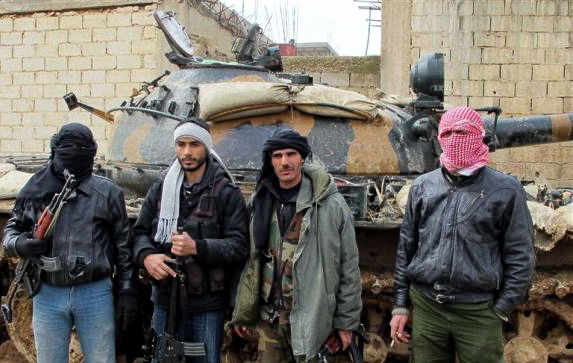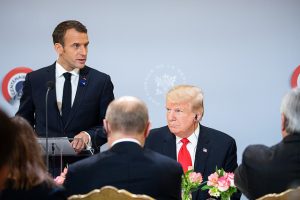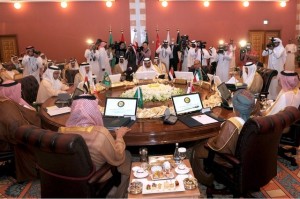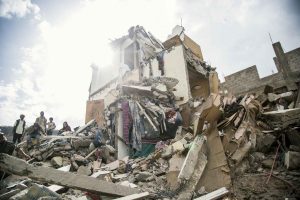Amidst UN envoy Lakhdar Brahimi’s attempts to achieve a temporary Syrian ceasefire, Secretary of State Hillary Clinton this week announced a boost in American non-lethal assistance to the Syrian rebels. Meanwhile, Russian Armed Forces Chief of Staff Nikolai Makarov declared that Moscow has “reliable information that Syrian militants have foreign…anti-aircraft missile systems, including those made in the USA.” Recent footage from Syria shows resistance fighters with shoulder-fired anti-aircraft missile launchers. But those seen were Russian-style SA-7’s possessed by the Syrian army and many other Middle East militaries, rather than advanced US models like the FIM-92 Stinger.
The question of whether to provide arms to the Free Syrian Army (FSA), which is fighting a desperate battle against the Assad regime, remains a difficult and conflicted decision for the US and most other NATO countries. For some, sending arms to the FSA to bring an earlier end to the regime and the continuing bloodshed and destruction is a “no-brainer”. Others maintain that giving the rebels more (and perhaps better) arms would only contribute further to the overall mayhem that might not end for quite a long time regardless.
For those wishing to respond to rebel pleas for arms, Islamist extremists — scattered among the scores of militias and local contingents comprising the FSA — are a central concern. As the civil war has dragged on, there has been rising evidence of these extremists fighting alongside rebel fighters, especially in the north where foreign correspondents have far more access. Many are Syrians, but a number of them have been coming in from neighboring countries to fight as scattered contingents within the FSA (or perhaps merely to find yet another venue for “jihad” against an unpopular secular regime).
And there is real reason for concern among governments sympathetic to the opposition about arms falling into the wrong hands. It is, after all, difficult to determine who would be the ultimate recipient of munitions assistance once it passes into Syria. In a fluid environment with scores of FSA factions, militant groups might also construct deceptive liaisons to convey false assurances of moderation once they catch wind of selective distribution. Finally, in cities like Aleppo, a number of armed factions appear to be fighting alongside each other and might feel compelled to share munitions for mutual support and protection against regime attacks. The injection of surface-to-air missiles into this conflict is especially risky because they could end up in the hands of terrorist groups and be used against commercial airliners.
That said, anger is increasing among anti-regime elements within Syria over the failure of the West to provide armed assistance. Had arms been supplied to Syrian rebels considerably sooner, the number of Syrians embittered over the lack of tangible support from the outside, the vast extent of destruction wrought mainly by the regime’s aircraft and heavy weapons, and the number of militants arriving from neighboring countries might have been more limited before the fall of the Assad regime (which this writer assumes is highly likely). The palpable rise in anger toward major Western powers for withholding arms could alone render more Syrians toward anti-Western Islamist appeals.
This, in a nutshell, is the US and Western dilemma. Standing by without providing vital arms while the bloodshed continues will probably mean less sympathy and increasing militancy among the rebels over time. After all, more of them (and members of their families) are being killed and maimed because they lack proper arms and sufficient ammunition.
On the other hand, if the rebels gain access to considerable more arms (meaning militants too in many cases), anti-Western anger would likely abate. But the conflict has already gone on long enough to produce a problematic post-Assad scenario featuring more robust militias competing for power, along with perhaps even more ugly sectarian score-settling against Alawite and Christian minorities that have been supporting the regime. In fact, the great amount of infrastructure, commercial establishments and all manner of housing already destroyed by regime firepower will likely be the source of a potentially profound economic crisis that would generate a heavy measure of frustration, anger and recrimination over some years even after the fall of the regime.
Consequently, in terms of the available options at this late stage in the struggle, those governments agonizing over the pros and cons of providing arms might well perceive the choice as a sort of “Catch-22.” In the context of the argument on the positive side of the policy ledger that providing arms could bring a swifter defeat of the regime, there is one more possible plus. So far, major Syrian Army units have not chosen to defect en masse, probably because (in addition to the obvious regime-loyalty notion) many realize facing off against the regime would be considerably more dangerous than combating relatively lightly armed rebel contingents. Should, however, rebel forces become considerably more militarily formidable, that shift might trigger such defections and a change on the ground that could be more significant than what the rebels have achieved so far. That said, even if plenty of additional arms were provided, the FSA is unlikely to receive tanks, other armored vehicles and heavy artillery that could match regime capabilities because most rebel fighters are not army defectors and would not be able to operate these more complex weapon-systems nearly as effectively as the Syrian military. So, not only has the US evidently provided little or no arms to the Syrian opposition, Washington may well remain (like many other potential Western suppliers) quite conflicted with respect to doing so.






I cannot really agree with the premises of this article. What about the fact that Qatar, an enemy of the Assad-regime, presented polls that outright claimed, if true, that a small majority of the syrian population is siding with the regime in this conflict? True, those polls might be considered old by now, but shouldnt they at least give us reason to question Wests support for the rebels? And had this conflict developed into a civil war if the outside actors had refrained from arming the rebels? Isnt it rather more likely that the violence would have been significantly less intense had the rebels not been brought fresh supplies to prolong their fighting?
However much we might dislike the dictatorship, are these not questions we have a responsibility to ask? Anyones thoughts?
Sir,
civilian casualties have increased markedly as the rebels brought the conflict into major cities. As their arsenal has grown so has their activity level and the brutal Regime response.
Arming the rebels so they can ‘defend’ themselves is a fallacy. When armed they routinely adopt offensive operations such as the assaults on Aleppo and Damascus (with seemingly little thought to the consequences for the local civilians).
The US should not overly worry about its popularity among the Syrian people. Despite all the positive effort in Pakistan and Iraq it remains unpopular in these countries. If it sought nothing but peace it might attract favourable feelings.